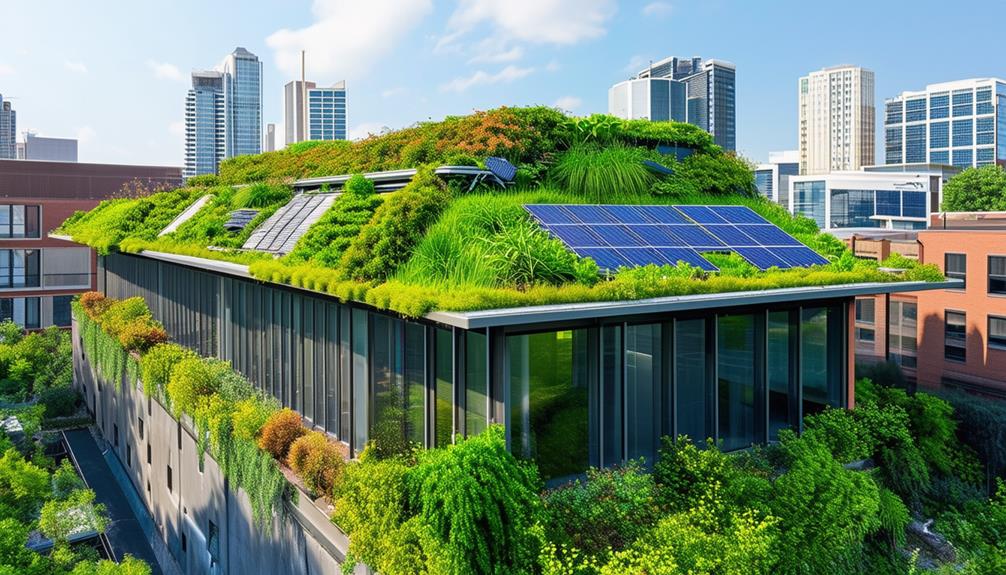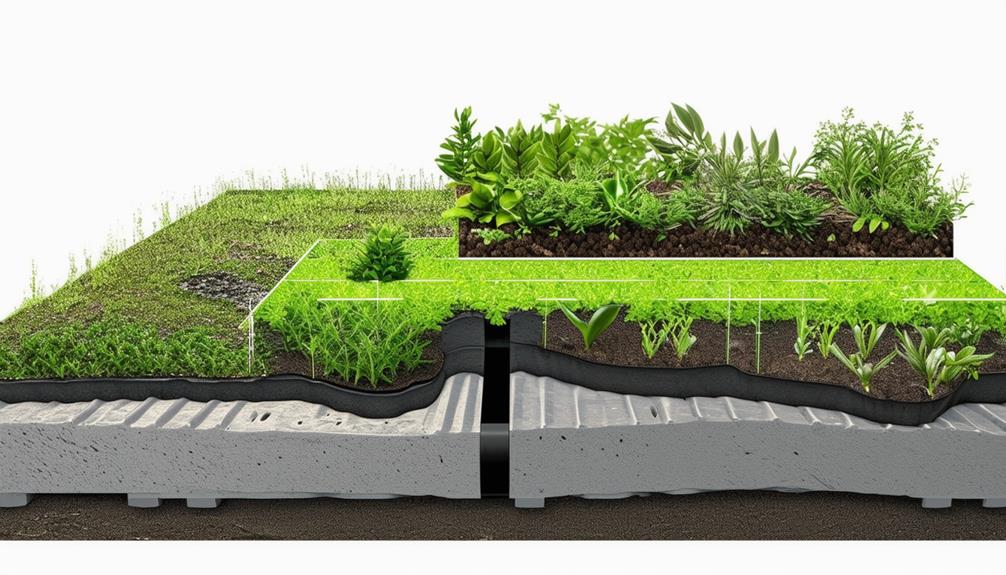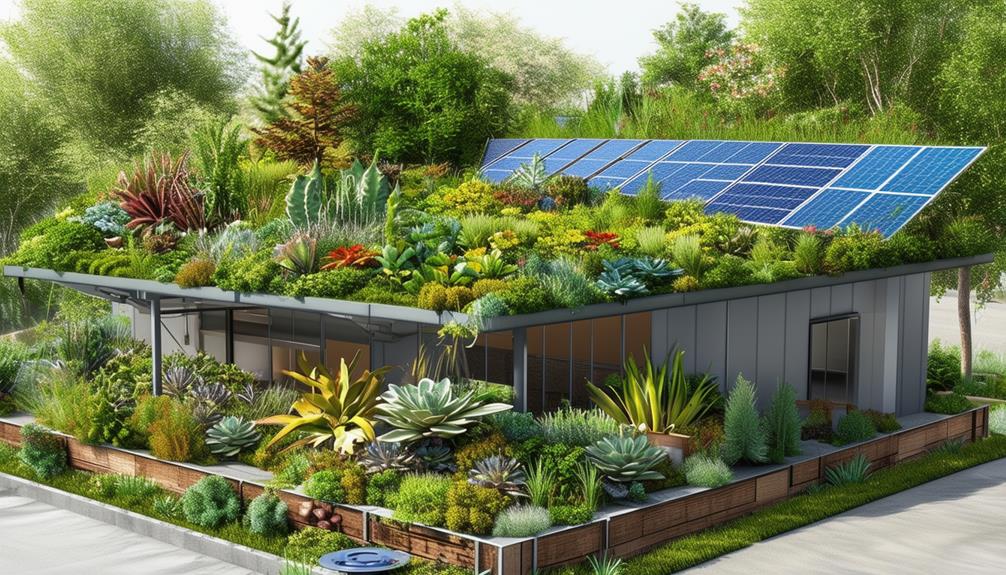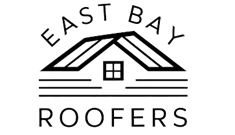When starting on green roof installation and maintenance, consider the myriad benefits like energy savings, improved air quality, and biodiversity support for a holistic building approach. Explore the two main types of green roof systems—extensive and intensive—and evaluate structural support and irrigation needs. Essential steps include evaluating drainage systems, selecting the right green roof system, ensuring proper waterproofing, and choosing the ideal vegetation. To maintain your green roof, adhere to seasonal pruning, regular drainage inspection, weed control, and prompt issue resolution. Plus, explore further into sustainable roofing materials, maintenance requirements, and cost considerations for a thorough understanding.
Benefits of Green Roofs

Installing a green roof on your building offers numerous environmental and economic benefits. One significant advantage is the energy savings that green roofs provide. By insulating buildings, green roofs can reduce the need for heating in winter and cooling in summer, resulting in lower energy consumption and cost savings for you. Additionally, green roofs help combat the urban heat island effect, where cities experience higher temperatures due to the abundance of concrete and asphalt surfaces. The vegetation on green roofs helps to absorb and deflect heat, reducing the overall temperature in urban areas and improving air quality.
Furthermore, the environmental impact of green roofs is substantial. They aid in reducing stormwater runoff by absorbing rainwater and decreasing the strain on drainage systems, preventing pollution of water bodies. Green roofs also contribute to biodiversity by providing habitats for birds, insects, and plants in urban environments. Overall, the installation of a green roof not only benefits you economically but also positively impacts the environment and urban communities.
Types of Green Roof Systems
When thinking about green roof systems, it's essential to understand the differences between extensive and intensive setups. Each type offers distinct benefits – extensive systems are lightweight and low-maintenance, while intensive systems allow for a greater variety of plantings. During installation, factors like structural support and irrigation requirements must be carefully considered to guarantee the success of your green roof project.
Extensive Vs. Intensive
In the domain of green roof systems, the distinction between extensive and intensive designs lies in their depth, maintenance requirements, and the types of vegetation they can support. Extensive green roofs are shallow, typically ranging from 2 to 6 inches deep, and are often lighter in weight compared to intensive systems. They are designed to support low-growing, hardy plants like sedum, grasses, and herbs. These roofs require minimal maintenance, primarily consisting of occasional weeding and irrigation.
On the other hand, intensive green roofs are deeper, usually exceeding 6 inches, allowing for a more diverse selection of plants such as shrubs, trees, and even gardens. While intensive green roofs offer more flexibility in plant choices, they also require more maintenance, including regular watering, fertilizing, and pruning. The environmental impact of extensive green roofs tends to be lower than that of intensive ones due to their reduced weight and simpler maintenance requirements. However, intensive green roofs provide more significant insulation benefits and can potentially contribute to better air quality. When considering a green roof installation, the cost comparison between extensive and intensive systems should also be taken into account, with extensive systems generally being more cost-effective upfront.
Benefits of Each
The distinct advantages of extensive and intensive green roof systems lie in their respective environmental impacts and maintenance requirements. Extensive green roofs, with their shallow soil depth and low maintenance vegetation like sedum and grasses, offer significant cost savings due to their lightweight construction and minimal upkeep needs. These systems excel by reducing stormwater runoff, mitigating the urban heat island effect, and enhancing biodiversity. On the other hand, intensive green roofs, characterized by deeper soil profiles supporting a more diverse range of plantings such as trees and shrubs, provide enhanced energy efficiency by offering better insulation and cooling properties to buildings. They also add to the aesthetic appeal of a structure with their lush vegetation and potential for recreational spaces. While intensive green roofs demand more maintenance and investment upfront, the long-term benefits regarding environmental sustainability and visual enhancement are substantial.
Installation Considerations
Considering the diverse range of green roof systems available, understanding the types and their unique characteristics is essential for successful installation and best performance. When selecting a green roof system, it is important to evaluate the drainage systems and waterproofing membranes.
There are two main types of green roof systems: extensive and intensive. Extensive green roofs are lightweight and low maintenance, typically featuring shallow soil depths and drought-resistant plants. These systems are well-suited for eco-friendly stormwater management. On the other hand, intensive green roofs have deeper soil depths, allowing for a wider variety of plant choices, including trees and shrubs. While intensive systems offer more design flexibility, they require more maintenance and structural support.
Proper drainage systems are crucial to prevent water accumulation, minimize weight load, and maintain roof integrity. Waterproofing membranes act as a protective barrier, safeguarding the building structure from water infiltration. Understanding these components will help you choose the right green roof system for your project.
Installation Process Overview

To commence the installation process of a green roof, the first step involves evaluating the structural integrity of the building. Ensuring that the structure can support the additional weight of the green roof is vital for its successful installation. Once the assessment is completed, the next step is to choose the appropriate type of green roof based on the benefits it offers. Green roofs provide numerous advantages, including reducing energy costs, mitigating the urban heat island effect, and improving air quality, thereby positively impacting the environment.
After selecting the green roof type, the installation process begins with the waterproofing layer, followed by the root barrier, drainage layer, filter fabric, growing medium, and finally, the vegetation. Each step is essential in creating a sustainable and functional green roof that not only enhances the building aesthetically but also contributes to environmental conservation. Proper installation is key to maximizing the benefits of a green roof while minimizing maintenance requirements in the future.
Maintenance Requirements and Tips
How can you guarantee the longevity and peak performance of your green roof through proper maintenance practices? To ensure your green roof thrives, it is important to adhere to a consistent maintenance routine. Seasonal pruning is essential to control the growth of plants and maintain their health. Regularly inspect and clean the drainage system to prevent water accumulation and potential leaks. Weed control is another crucial aspect of maintenance to prevent unwanted plants from competing with your green roof vegetation. Proper irrigation management is key to providing adequate water without over-saturating the roof substrate.
For efficient maintenance, schedule regular inspections to identify any issues promptly. Address any drainage problems immediately to prevent water damage. Implement a weed control program to keep unwanted plants at bay. Adjust your irrigation system based on the changing needs of the vegetation and weather conditions. By staying proactive and diligent in your maintenance efforts, you can ensure that your green roof remains in top condition for years to come.
Sustainable Roofing Materials

When considering sustainable roofing materials, you have a range of eco-friendly options to choose from. These materials not only benefit the environment but also offer increased longevity and durability for your roof. Exploring the benefits of sustainable materials can lead to a greener and more resilient roofing solution for your building.
Eco-Friendly Roofing Options
Explore sustainable roofing materials that are not only environmentally friendly but also durable and cost-effective for long-term green roof installations. When choosing eco-friendly roofing options, consider the following:
- Sedum Roofing: Sedum plants are a popular choice for green roofs due to their ability to thrive in various climates and their low maintenance requirements. They provide excellent insulation and stormwater management benefits.
- Recycled Shingles: Made from recycled materials such as rubber, plastic, or wood fibers, recycled shingles offer a sustainable alternative to traditional asphalt shingles. They are durable, energy-efficient, and contribute to reducing landfill waste.
- Metal Roofing: Metal roofs are long-lasting and recyclable, making them an eco-friendly choice for green roofs. They reflect sunlight, reducing heat absorption and energy costs while providing a sleek, modern look to the building.
When considering eco-friendly roofing options, keep in mind to also plan for appropriate plant selection and efficient drainage systems to ensure the longevity and effectiveness of your green roof project.
Benefits of Sustainable Materials
Reveal the array of advantages that sustainable roofing materials offer for green roof installations and long-term maintenance. Sustainable roofing materials bring a host of benefits to your green roof project. To begin with, they enhance energy efficiency by providing better insulation, reducing heating and cooling costs over time. By choosing sustainable materials, you contribute positively to the environment by lowering your carbon footprint and minimizing the use of non-renewable resources, thereby reducing the overall environmental impact of your building.
Moreover, opting for sustainable materials can lead to significant cost savings in the long run. While initial costs may be slightly higher than traditional materials, the durability and efficiency of sustainable options result in lower maintenance and replacement expenses. Additionally, sustainable roofing materials often offer a sleek and modern aesthetic appeal, enhancing the overall look of your building and adding value to your property. So, make a sustainable choice today for a greener future with benefits that extend beyond just energy efficiency and environmental impact.
Longevity and Durability
Sustainable roofing materials are renowned for their exceptional longevity and durability, making them a wise investment for green roof installations. When contemplating the lifespan of a green roof, the choice of roofing materials plays an essential role. Here are some key points to keep in mind:
- Green Roof Lifespan: Opting for sustainable materials can greatly extend the lifespan of your green roof, providing lasting benefits for years to come.
- Weather Resistance: Sustainable roofing materials are designed to withstand various weather conditions, ensuring your green roof remains durable and reliable in the face of the elements.
- Roof Durability and Maintenance Tips: Proper maintenance is vital to maximize the durability of your green roof. Regular inspections, timely repairs, and routine cleaning can help prolong the lifespan of your sustainable roof, maintaining its efficiency and performance over time.
Green Roof Cost Considerations
Considering the costs associated with installing and maintaining a green roof is essential for effective planning and budgeting. Before starting on a green roof project, conducting a thorough cost analysis and creating a detailed budget plan is vital. While the initial investment for a green roof may be higher than traditional roofing options, it is important to weigh the financial implications against the long-term savings that can be achieved. Factors such as the type of green roof system, installation complexity, and maintenance requirements all contribute to the overall cost considerations.
When evaluating the cost of a green roof, it is essential to look beyond the upfront expenses and consider the potential savings over the lifespan of the roof. Green roofs offer benefits such as improved energy efficiency, extended roof lifespan, and reduced stormwater runoff, which can lead to significant cost savings in the long run. By carefully analyzing the costs and benefits of a green roof, you can make informed decisions that align with your budget and sustainability goals.
Frequently Asked Questions
Can Green Roofs Attract Pests or Insects?
Yes, green roofs can attract pests or insects if proper pest prevention measures are not in place. To control insects, regular inspections and maintenance are essential. Implementing strategies like sealing entry points and using non-toxic repellents can deter pests effectively. Promptly addressing any signs of infestation is vital to maintaining a healthy environment on green roofs. Stay vigilant and proactive in managing pest and insect issues to guarantee the longevity of your green roof.
Do Green Roofs Require Special Watering Systems?
Watering frequency is a critical factor in maintaining green roofs. These specialized roof systems often require irrigation systems to guarantee proper hydration for the vegetation. Without adequate watering, plants can wither and die, impacting the roof's overall health and functionality. Installing a suitable irrigation system tailored to your green roof's needs is essential for its long-term success and sustainability. Be mindful of the watering schedule to keep your green roof thriving.
How Do Green Roofs Impact Building Insurance Rates?
Insurance implications of green roofs can lead to cost savings in building insurance rates. Green roofs can mitigate risks associated with water damage, fire hazards, and extreme weather events, potentially reducing insurance premiums. These environmentally friendly installations are often viewed positively by insurers due to their ability to enhance building durability and energy efficiency. By investing in green roofs, you could not only benefit the environment but also enjoy financial advantages through lower insurance costs.
Are There Regulations for Installing Green Roofs?
When it comes to Regulations compliance for installing green roofs, it's important to follow local building codes and permit requirements. The Installation process must adhere to specific guidelines to guarantee safety and structural integrity. Be sure to consult with professionals familiar with green roof installations to navigate any regulatory hurdles smoothly. By staying informed and compliant with regulations, you can guarantee a successful and sustainable green roof project.
Can Green Roofs Support the Weight of Solar Panels?
Yes, green roofs can indeed support the weight of solar panels. This compatibility depends on the structural integrity of the green roof. When considering this setup, it's important to factor in maintenance costs and energy efficiency. Proper installation and upkeep guarantee that the green roof can effectively support solar panels while maximizing energy efficiency. This combination can lead to a sustainable and eco-friendly solution for your building.
Conclusion
As you gaze out over your cityscape, envision the lush, thriving oasis of green roofs providing numerous benefits to the environment and your building. By choosing sustainable materials, proper installation, and regular maintenance, you are not only improving the aesthetics of your roof but also contributing to a healthier planet. Embrace the beauty and functionality of green roofs, and watch as your urban landscape transforms into a vibrant, sustainable paradise.




